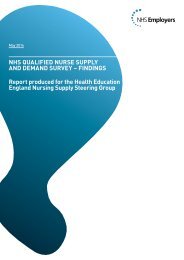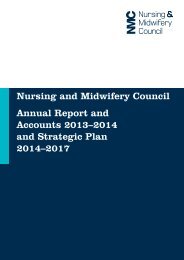Journal_1_2014_final_WEB
Journal_1_2014_final_WEB
Journal_1_2014_final_WEB
You also want an ePaper? Increase the reach of your titles
YUMPU automatically turns print PDFs into web optimized ePapers that Google loves.
Science, Practice and Education<br />
Efficacy of platelet-rich<br />
plasma for the treatment of<br />
chronic wounds<br />
Abstract<br />
Aim: To assess the efficacy of platelet-rich<br />
plasma for the treatment of patients with<br />
chronic wounds of various aetiologies.<br />
Methods. We analysed the treatment outcomes<br />
in 81 patients with chronic wounds<br />
of various aetiologies. For the treatment of<br />
44 patients (experimental group), we used<br />
platelet-rich plasma flat clot therapy starting<br />
from phase II of the wound healing process.<br />
The frequency of dressing changes was once<br />
in 7 days, an interval that allowed patient<br />
transfer to outpatient care. For the treatment<br />
of 37 patients (control group), traditional<br />
topical agents were used.<br />
Results. In three patients, owing to a large<br />
area of chronic wounds, 3-4 autodermoplastic<br />
closures of the wound were performed;<br />
85.4% of patients achieved complete wound<br />
re-epithelialisation within 46.4 ± 4.3 days. In<br />
the control group, the autodermoplastics operation<br />
was performed in three patients, and<br />
only 11.8% of patients achieved wound reepithelialisation<br />
within 3 months. The mean<br />
inpatient hospital duration was 11.0 ± 2.5<br />
days in the experimental group and 23.1 ±<br />
1.5 days in the control group. The mean cost<br />
of treatment was 785.25 Euros and 1649.02<br />
Euros per patient in the experimental and<br />
control groups, respectively.<br />
Conclusions. The treatment of patients with<br />
chronic wounds using platelet-rich plasma is<br />
safe, clinically beneficial and cost effective.<br />
Introduction<br />
The treatment of chronic wounds of different aetiologies<br />
is a topical issue of modern medicine. The acceleration<br />
of reparation processes and tissue regeneration<br />
entails not only clinical but also economical and social<br />
effects.<br />
In the late 1990s, Robert E. Marx described the<br />
method of obtaining platelet-rich plasma (PRP) and<br />
its use as a gel in dentistry [1] . In 1994, Eduardo Anitua<br />
demonstrated that the PRP gel helps to accelerate<br />
bone regeneration and confirmed the presence of specific<br />
platelet-derived growth factor receptors (PDGFs)<br />
in the bone tissue [2] . In 2001, Russian scientists R.R.<br />
Akhmerov and R.F. Zarudiy developed the Plasmolifting<br />
TM technique that included the production and use<br />
of PRP injections in dentistry and dermatocosmetology<br />
[3,4] .<br />
PRP is a platelet suspension in plasma derived from<br />
human blood. The platelet concentration in PRP is<br />
2- to 6-fold higher than that in total blood and may<br />
reach 1000 × 10 9 /L [5] . Platelets contain growth factors<br />
that are attracted locally to damaged progenitor<br />
cells to stimulate their proliferative activity and<br />
improve wound healing via autocrine and paracrine<br />
mechanisms. Platelet growth factors include PDGF,<br />
platelet-derived angiogenesis factor (PDAF), transforming<br />
growth factor-b (TGFb), insulin-like growth<br />
factor (IGF), platelet-derived endothelial cell growth<br />
factor (PD-ECGF), epidermal growth factor (EGF),<br />
fibroblast growth factor (FGF), thrombospondin and<br />
osteonectin [6] .<br />
PDGF plays a particular role in tissue reparation<br />
and regeneration. PDGF was shown to stimulate the<br />
proliferative, secretory and migratory activity of mesenchymal<br />
cells [7] and is a co-factor for other growth factors<br />
– e.g., the angiogenic vascular endothelial growth<br />
factor (VEGF) [8] . Growth factors are released after human<br />
platelet activation. Once activated, the platelets<br />
release approximately 70% of their stored growth factors<br />
within the first 10 minutes. Complete release of<br />
platelet growth factors is accomplished within 1 hour.<br />
Therefore, it is recommended to activate platelets immediately<br />
before using PRP [9-11] .<br />
<br />
Vladimir N. Obolenskiy,<br />
PhD, Ass. Professor 1,2<br />
Darya A. Ermolova,<br />
PhD 2<br />
Leonid A. Laberko,<br />
MD, Professor 2<br />
Tatiana V. Semenova,<br />
PhD 2<br />
1)<br />
SBHI City hospital<br />
no.13, Moscow<br />
2)<br />
Department of General<br />
Surgery, Medical Faculty<br />
of Russian National-<br />
Research Medical<br />
University named after<br />
N.I. Pirogov, Moscow<br />
Correspondence:<br />
Vladimir N. Obolenskiy,<br />
gkb13@mail.ru<br />
Conflict of interest: none<br />
EWMA <strong>Journal</strong> <strong>2014</strong> vol 14 no 1 37




